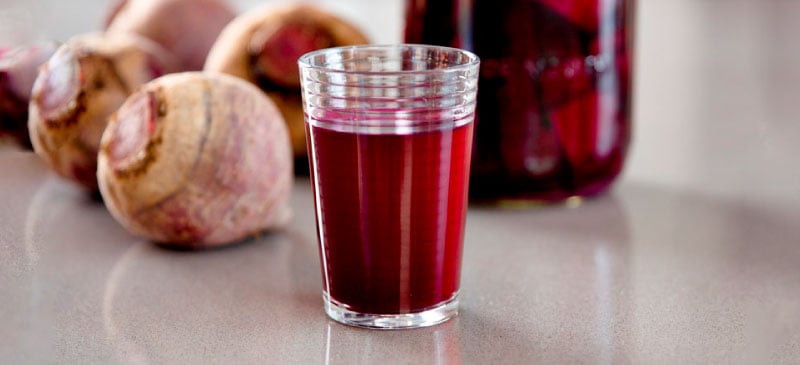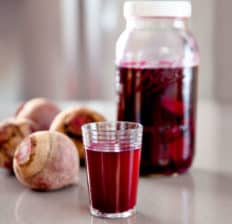Kvass: the Fermented Beverage with Probiotic Benefits

If you haven’t seen kvass at the grocery store, chances are you soon will. Already produced in places like Brooklyn and Pennsylvania, kvass is quickly catching up with kombucha as the most popular probiotic drink.
Kvass is a traditional fermented beverage that has a similar taste to beer, except it’s healthier because it provides probiotics. It’s actually made from stale, sourdough rye bread or beets, meaning it’s cheap and sustainable to make.
In the U.S., kvass is pretty much synonymous with lacto-fermented beet juice or beet brine, since this is the more popular type.
In addition to its impressive probiotic content, kvass is considered a tonic for digestion and an excellent thirst quencher. Below we’ll look more closely at its body-wide benefits, plus how to make it yourself at home.
What Is Kvass?
Kvass is a fermented drink that originated in Eastern Europe. It’s still most popular in places such as Ukraine and Russia, but it’s becoming more widely available in the U.S., Australia and other parts of Europe.
It’s sometimes also called “bread soda” or “Russian cola.”
Even though it’s gained attention recently, as probiotic drinks have become a health trend, kvass is anything but new. It was first mentioned in the “Primary Chronicle,” an ancient history book of Slavic people, in the year 996 A.D., meaning it’s more than 1,000 years old.
In historical times, it was often favored over water that could be contaminated. That’s because fermentation helps lower the pH of water enough to kill some bad bacteria, which means it’s protective.
Russians have been consuming kvass for centuries. The wealthy made various kinds of kvass using rye bread or pears, raisins, cherries, bilberries and lingonberries. No traditional Ukranian home was without its bottle of beet kvass, according to Lubow A. Kylvska, author of “Ukranian Dishes.” Kvass was said to be “handy and ready when a pleasing, sour flavor had to be added to soups and vinaigrettes.”
Folk medicine values beets and beet kvass for their liver-cleansing properties, and beet kvass is widely used in cancer therapy in Europe. It has been reported that beet kvass is an excellent therapy for chronic fatigue syndrome, chemical sensitivities and allergies, and because it is an excellent source of probiotics, it can help with digestive problems.
Kvass Questions
What does kvass taste like?
While it’s tart when not flavored, it can be quite refreshing when mixed with fruits (such as raisins and strawberries) and herbs (such as mint). It typically has a tangy, earthy, salty flavor and can be an acquired taste, though many end up craving it due to the nutritional benefits it offers.
Is kvass the same as kombucha?
Kombucha is another probiotic drink that has similar benefits and a naturally tart taste, but the two are made with different primary ingredients.
Kombucha is made with tea, sugar and often fruit. It also requires a symbiotic culture of bacteria and yeast (SCOBY) to ferment and tends to be a bit sweeter.
Both drinks are essentially “alive” since they contain active bacteria that support digestion. One advantage that kvass has is that it possesses both benefits of probiotics along with nutrients from the beets.
Is kvass an alcoholic drink?
While kvass is considered a non-alcoholic beverage, containing around 0.5 percent to 1 percent alcohol, the longer it ferments, the more susceptible it is to becoming more alcoholic. It typically doesn’t contain enough alcohol to impair someone’s judgment or cause other side effects, but strong varieties may potentially make people feel as if they’ve consumed a small amount of alcohol.
It is made with yeast?
It depends on the specific type of kvass. Traditionally, it was not made with yeast, but today some types made with stale bread use dry active yeast to help the fermentation process.
The oldest recipes used bread and beets to provide fermentable sugar instead of adding yeast. This is said to result in a better taste than when yeast is used.
Yeast can make the process easier, but it’s not necessary to use. Some people prefer using sourdough starter instead, which may make the taste more mild and pleasant.
Nutrition Facts
Kvass is considered a “functional food” because it offers a wide range of probiotics and nutrients, including vitamin B12, selenium and manganese.
If made with beets, it also contains a good dose of antioxidants, natural nitrates, vitamins A and C, and potassium.
Below is the nutritional background based on a four-ounce serving of kvass made with beets (according to the U.S. Department of Agriculture). Note that nutrition content varies based on the exact ingredients used, as the bread variety offers different nutrients.
One four-ounce (1/2 cup) serving of kvass made with beets contains about:
- 35 calories
- 8 grams carbohydrates
- 1 grams protein
- 2 grams fiber
- 6,500 international units of vitamin A (130 percent DV)
- 4.8 milligrams vitamin C (8 percent DV)
- 0.4 milligrams iron (2 percent DV)
- 20 milligrams calcium (2 percent DV)

Benefits
1. Great Source of Probiotics
Since kvass is considered one of the great probiotic foods, there are many benefits, such as improving intestinal tract health and enhancing the immune system, which makes nutrients more available to the body. It’s also one of the best drinks for gut health.
Probiotics in your diet, including from kvass, have been shown to increase gut microflora diversity and support metabolic activity, while also potentially having appetite-reducing effects. Probiotic drinks may also help reduce symptoms of lactose intolerance, including diarrhea, and decrease the prevalence of food allergies.
Formerly, we had plenty of probiotics in our diets from eating fresh foods from good soil and by fermenting our foods to keep them from spoiling. The modern ways of agriculture, refrigeration and preparing food have eliminated probiotic foods for too many Americans.
Not enough probiotics can mean digestive disorders, skin issues, candida, autoimmune disease, and frequent colds and flus.
2. Excellent Liver Cleanser
While many think that alcohol is the only reason for liver problems, disease-causing inflammation is also caused by poor eating choices.
Beets and beet greens are rich in antioxidants and potassium, and as such, they help fight free radical damage that can contribute to the aging process and some diseases.
Like beetroot juice, beet kvass and beets help naturally cleanse the gallbladder, improve bile flow, remove plenty of toxins and promote regularity. They also be part of a natural liver cleanse.
3. Perfect Blood Tonic
Beets contain phytonutrients called betalains that are found in the pigment of beets. (They are what causes your hands to stain.) These betalains help create red blood cells, making beet kvass an excellent blood tonic by alkalizing the blood.
Why is this important? When your bloodstream becomes too acidic, it causes inflammation in the body and depletes the body of calcium because it is trying to balance out the pH levels.
One of the best things we can do is consume more alkaline-promoting foods, such as beets and leafy green vegetables.
4. May Help Reduce the Risk of Cancer
Most significant of all, beet kvass may help as a natural cancer fighter because of the combination of antioxidant and anti-inflammatory properties available.
According to a 2014 report published in the journal Nutrients, beetroot is also considered as a therapeutic treatment for inflammation, and its antioxidant and anti-inflammatory properties may help reduce the risk of certain types of cancer.
5. Beet Kvass Is Rich in Valuable Nutrients
Because beets are high in vitamin C, beet kvass helps boost your immune system and can help stave off the cold virus.
It’s also very high in manganese, a mineral that is needed for maintenance of healthy bones, plus liver, kidney and pancreatic functions. Beet kvass also contains the B vitamin known as folate, which may help reduce the risk of birth defects.
How to Make
Most brands of commercialized kvass lack many of the benefits associated with the traditional types because they’re low in probiotics. This is why fermenting your own is recommended.
Making homemade kvass takes a little practice, but overall it’s simple and inexpensive to make. The simplest recipes include ingredients like beets, water and salt.
The water and salt create a brine so the beets pickle, and eventually the brine becomes kvass with a slight effervescence. When the beets ferment they naturally produce a bit of bubbles (same with kombucha), so you can expect the finished product to be slightly fizzy.
A few helpful tips:
- When making kvass, your water needs to be pure and chemical-free. If you use chlorine or chemical-laden water, it will prevent the bad bacteria from forming as well as the good bacteria and will cause the beets to rot. Filtered spring water is best. If you use tap water, make sure you eliminate the chemicals by boiling or by leaving the water out overnight so the chlorine can evaporate.
- Beets should be organic. If you don’t use organic beets, make sure they are fresh, and peel them to help rid them of possible pesticide residue.
- You want to chop the beets into one- to two-inch chunks. Don’t shred them as it can cause too much sugar to be released.
Ready to start making kvass at home? There are two popular kvass recipes. The first recipe takes a bit more time and uses rye bread. The second is a recipe for beet kvass and takes only a few minutes to prepare. (See the recipe card below.)
For kvass using bread, here are some useful tools and things to know:
- Thermometer that measures liquids between 50–175 degrees F.
- A warm place in your kitchen (about 76–78 degrees) can help with the fermentation process.
- It is important to use bread that is made only with rye flour and without food additives — if you include oats or other grains and preservatives, it may cause a bitter taste.
- While you can make your own rye bread, your local health food market should be able to provide quality bread.
- Don’t worry about the sugar content, as most of the sugar will be turned into beneficial acids due to fermentation.
- Look for the finished product to be lightly carbonated, with bubbles just barely detectable. If you let it ferment for too long it will become unpleasant-tasting.
- Once it’s ready, store the kvass in bottles with screw-on tops or tops with wire fasteners for a tight seal.
Risks and Side Effects
Among people who are new to drinking probiotic drinks, kvass can potentially give them stomachaches or other mild side effects at first. Introduce this drink to your diet slowly to minimize any reactions, such as nausea, heartburn or bloating.
Kvass side effects seem to be more of a risk when making it yourself because contamination is possible. If you’re going to make your own, be sure to use sterile equipment, clean working spaces and high-quality ingredients.
If you’re allergic to wheat or beets, avoid having kvass since this can trigger a reaction.
Print
Rye Bread or Beet Kvass Recipe
- Total Time: 2 days
- Yield: 10 1x
- Diet: Vegan
Description
Kvass is a traditional fermented beverage that has a similar taste to beer, except it’s healthier because it provides probiotics. It’s actually made from stale, sourdough rye bread or beets, meaning it’s cheap and easy to make. Here’s a rye bread kvass (popular in Russia) and a beet kvass (popular in Ukraine).
Ingredients
Rye Bread Kvass
- ½ pound sourdough rye bread (6–8 slices), cut into 1/4-inch slices
- ¾ cup organic pure cane sugar
- ½ package dry active yeast
- 1 teaspoon unbleached white flour
- filtered water
- about 6–8 raisins
Beet Kvass
- 2–4 beets
- ¼ cup of juice from your favorite sauerkraut recipe or similar fermented vegetable
- 1 tablespoon sea salt
- 2 tablespoons fresh mint leaves or 1 tablespoon dried [optional]
- filtered water
- half-gallon, large glass jar
- cheesecloth or thin towel
Instructions
Rye Bread Kvass
- Spread the bread on cookie sheets, and bake for 20 to 30 minutes at 325 degrees F until bread is dark brown. When cool, chop into 1/4-inch pieces.
- Bring 2 quarts of water to a boil in a large pot, and then cool to 175 degrees F. Add the bread, stirring well. Cover with a lid, and leave in a warm place for 1 hour. Strain and reserve both the bread and the liquid.
- Bring another 1 1/4 quarts of water to a boil, cool down to 175 degrees and add the reserved bread and raisins. Cover with a lid, and leave in a warm place for 90 minutes.
- Strain and discard the bread. Combine both batches of liquid.
- Place 1/8 cup sugar and 1 teaspoon of water in a small skillet.
- Stir continuously over heat until the mixture turns golden brown, but be careful not to burn it. Remove from heat, and gradually blend in 1/2 cup of the reserved liquid.
- Stir the mixture into the entire batch of liquid.
- In a small saucepan, combine 1/2 cup water and the remaining sugar.
- Bring to a boil, lower the heat and simmer for 10 minutes, skimming once or twice.
- Stir this syrup into the reserved liquid, and allow the mixture to come to room temperature.
- Mix the yeast with the flour, and combine with 1/2 cup of the liquid. Return this yeast mixture to the pot.
- Cover the pot with 2 layers of cheesecloth or a kitchen towel, and leave in a warm place for 8–12 hours or overnight.
- Cool the kvass to about 50–54 degrees F. Transfer to bottles, seal tightly and refrigerate for 24 hours. The kvass will keep in the refrigerator for 2–3 days.
Beet Kvass
- Wash beets, and peel if you are not using organic beets. You can leave the skin on if you are using organic beets.
- Chop the beets into small cubes.
- Place the beets into a large jar.
- Add the fermented juice, salt and mint leaves.
- Fill the jar with filtered water.
- To ferment, cover with a towel or cheesecloth, and leave the jar open on the counter or in a warm place at room temperature for 2 days.
- Place in the fridge, and consume as desired. Several ounces per day can aid in creating a healthy gut.
- Enjoy it as a refreshing drink, and try adding it to both hot and cold soups, sauces and dressings.
- Prep Time: 10 min
- Category: Beverages
- Method: Fermenting
- Cuisine: Russian/Ukrainian
Nutrition
- Serving Size: 4 ounces
- Calories: 35
- Sugar: 4g
- Sodium: 602mg
- Fat: 0g
- Carbohydrates: 6g
- Fiber: 2g
- Protein: 0g
- Cholesterol: 0g
Comments
Please keep comments under 200 characters.



Step 4: how to I make the fermented juice please? thanks
I love that! They are just what I need! I appreciate you sharing these amazing and fulfilling experiences with me and with all of you.
That’s incredible! I tried the recipe you shared and it worked!Have a good time with your family and wordle unlimited online.
Make some labneh or yogurt cheese. Whey is the liquid that is created while the food is being drained. Pour in 1/4 cup of whey to start your ferment.
IO games
Can you use 1/4 cup of previous Kvas juice to make the next batch?
I’m not understanding why 2nd recipe lacks yeast/bread…Can u clarify for me?
What if you don’t have juice from your favorite sauerkraut recipe or similar fermented vegetable to use?!
Sheryl–simple. Make some yogurt cheese or labneh. The liquid produced during the draining process is whey. Use 1/4 cup whey to get your ferment going.
What if I don’t have fermented juice or whey from yogurt???
Sheryl – Maybe buy the one that appeals to you most fresh when you purchase your beets, and then consume what you don’t use in the recipe?
Mark – Thanks for your alternative suggestion.